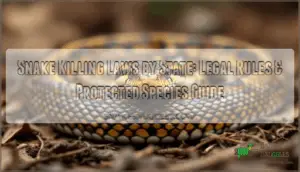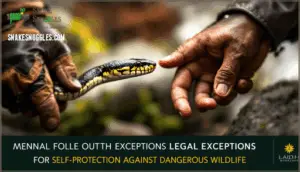This site is supported by our readers. We may earn a commission, at no cost to you, if you purchase through links.
 You might think killing a snake on your property is perfectly legal—until you face a $50,000 fine and criminal charges. Snake laws vary dramatically by state, and what’s allowed in Texas could land you in court in Georgia.
You might think killing a snake on your property is perfectly legal—until you face a $50,000 fine and criminal charges. Snake laws vary dramatically by state, and what’s allowed in Texas could land you in court in Georgia.
Twenty-one native snake species carry federal protection under the Endangered Species Act, while some states ban killing any snake at all. Misidentifying a protected species or acting in the wrong jurisdiction can turn a split-second decision into serious legal trouble.
Understanding your state’s specific regulations isn’t just about following the law—it’s about knowing when you can legally act and when you need to call a professional instead.
Table Of Contents
- Key Takeaways
- Federal Laws on Killing Snakes
- State Laws Strictly Protecting Snakes
- States With Limited Snake Protection
- States Without Specific Snake Laws
- Seasonal and Permitted Snake Hunting
- Legal Exceptions to Snake Killing Laws
- Penalties for Killing Protected Snakes
- Snake Identification and Legal Risks
- Snake Removal and Relocation Laws
- Snake Conservation and Public Safety
- Frequently Asked Questions (FAQs)
- Is it illegal to kill a snake?
- Are snake laws complicated?
- What laws stop people from killing snakes?
- Is it illegal to kill snakes in Virginia?
- Is it illegal to kill a snake in Texas?
- Is it illegal to kill snakes in Rhode Island?
- What state is it illegal to kill snakes?
- Can you kill a snake on your property?
- Why is it illegal to kill snakes in Tennessee?
- Why is it illegal to kill snakes in Virginia?
- Conclusion
Key Takeaways
- Federal law protects 21 native snake species under the Endangered Species Act with penalties up to $50,000 and one year imprisonment, overriding any state regulations that might allow killing those species.
- State snake laws vary dramatically—some states like Georgia and Maryland ban killing any snake species and treat violations as misdemeanors, while others like Texas allow most snake killing on private property with minimal restrictions.
- Misidentifying a protected snake doesn’t shield you from prosecution, as courts rarely accept confusion as a defense even when the mistake was honest, making accurate species identification critical before taking any action.
- Self-defense and livestock protection exceptions exist in most states, but you must prove an imminent threat and demonstrate that the danger was genuine and unavoidable, not just a snake casually crossing your property.
Federal Laws on Killing Snakes
Federal law protects certain snake species from being killed, even if your state allows it. The Endangered Species Act sets rules that apply everywhere in the country, overriding local regulations.
Here’s what you need to know about federal protections, which species are covered, and what happens if you break these laws.
Endangered Species Act Overview
The Endangered Species Act of 1973 stands as the primary federal shield between protected snakes and anyone who might harm them, whether by accident or intent. This federal law protects endangered species through a formal listing process that designates critical habitat and establishes recovery plans.
You can’t kill, harm, or possess ESA-listed snakes without facing serious federal penalties, and citizen suits allow private individuals to enforce these snake protection laws when authorities don’t act.
Federally Protected Snake Species
As of October 2025, twenty-one native snake species hold federal protection under the Endangered Species Act (ESA). ESA protections prohibit killing, capturing, or possessing listed snakes without permits, while critical habitats receive safeguards from federal actions causing destruction.
Recovery efforts target species like the eastern indigo snake and San Francisco garter snake, addressing habitat loss and illegal snake trafficking through listing factors that trigger enforcement across state lines.
The U.S. Fish and Wildlife Service is proposing to list two additional snake species as endangered.
Federal Penalties and Enforcement
Violating the Endangered Species Act brings serious consequences—federal authorities can impose fines up to $50,000 per offense and criminal penalties including imprisonment up to one year for knowingly killing protected snakes. Enforcement agencies, including the U.S. Fish and Wildlife Service, investigate violations across federal jurisdiction, often relying on citizen reporting to identify offenders.
Penalty severity escalates for repeat violations or commercial trafficking. International treaties extend federal protection beyond U.S. borders, creating legal liability even for cross-border snake trade violations.
State Laws Strictly Protecting Snakes
While most states allow some level of snake killing, several have put strict protections in place that make it illegal to harm almost any snake. These laws recognize the ecological value of snakes and impose real consequences for violations.
Let’s look at which states take snake protection seriously, what species they safeguard, and what happens if you break these rules.
States With Blanket Snake Protection
Some states don’t mess around regarding snakes—they protect every species within their borders, no exceptions. These state-by-state snake laws create blanket coverage, making it illegal to kill any snake, regardless of whether it’s venomous or harmless. Conservation effectiveness runs high in these jurisdictions, though enforcement challenges persist.
States with complete protection benefits include:
- Alabama – Protects all snakes, with specific emphasis on Eastern indigo and Eastern coral snakes
- Georgia – Makes killing or possessing snakes a misdemeanor under state regulations
- Maryland – Enforces total snake species protection across all native populations
Key Protected Species by State
Across New York’s forested ridges and wetlands, you’ll find the Eastern Massasauga rattlesnake enjoying federal and state-level endangered species protections. Connecticut’s endangered species laws single out the timber rattlesnake as their only protected snake. New Mexico state laws shield the gray-banded kingsnake, narrow-headed garter snake, and New Mexico ridge-nosed rattlesnake through species-specific regulations. Virginia’s Wildlife Action Plan identifies multiple snake species as conservation priorities, requiring habitat conservation and population monitoring.
These state-specific snake regulations demonstrate how legal enforcement aids species recovery beyond federal protections. To better understand their behavior, Connecticut DEEP initiated a timber rattlesnake telemetry project in 2024.
Penalties for Unlawful Killing
If you kill a protected snake in states like Georgia or Maryland, you could face misdemeanor charges. But what happens when federal endangered species laws stack on top of state penalties? Federal fines can reach $50,000 per violation, with jail time up to one year for first offenses.
State penalties vary, but misdemeanor convictions usually bring $500 to $5,000 fines and possible imprisonment. Poaching consequences multiply when misidentification defense fails—restitution costs for ecosystem damage can exceed prosecution expenses.
States With Limited Snake Protection
Not every state gives snakes blanket protection, but many still have rules worth knowing. Some protect specific species, others require a hunting license, and a few carve out exceptions when danger’s involved.
Let’s look at how these limited-protection states address snake laws.
Species-Specific Protection
Many states don’t ban all snake killing—instead, they protect specific endangered species while allowing you to manage others with proper permits. Illinois, for example, designates 11 native snakes as endangered or threatened under state law, making their removal illegal. Florida protects the eastern indigo and rim rock crowned snakes as species of special concern due to severe habitat loss. Nebraska restricts killing of Timber Rattlesnakes and Prairie Kingsnakes, while New Mexico limits harvest of Gray-Banded Kingsnakes through annual bag limits.
State designations drive conservation efforts and population monitoring for at-risk species.
Hunting License Requirements
You’ll need proper authorization before you can legally take or move most snakes—even those that aren’t fully protected—in several states across the country. Kansas requires a hunting license to take snakes, with specific state-by-state snake laws protecting the Eastern Massasauga rattlesnake. Idaho allows snake hunting with a valid license, though species limitations apply.
License cost, age restrictions, and hunter education requirements vary greatly under snake hunting regulations, so check your state’s snake regulations before pursuing any capture or removal activities.
Allowed Exceptions
Even with a hunting license in hand, most states carve out specific situations where you can take action against snakes without jumping through regulatory hoops. Self-defense commonly allows immediate action when facing an imminent threat on private property. Livestock defense provisions permit you to protect animals from immediate danger under most state law.
Public safety exceptions address property damage scenarios, though legal ambiguity often surrounds what qualifies as a genuine emergency versus preventable conflict.
States Without Specific Snake Laws
Some states take a hands-off approach regarding snakes. Alaska, Hawaii, Montana, North Dakota, and South Dakota don’t have specific laws protecting snakes from being killed.
Here’s what that means if you live in one of these states.
States Lacking Snake Protection
A handful of states treat snakes like any other wild creature you might encounter—no special rules, no blanket protection, and no penalties for killing them unless they’re on the federal endangered list. Alaska, Hawaii, Montana, North Dakota, and South Dakota have no state-specific snake regulations.
This lack of state law means you can legally kill most snakes without facing prosecution, though ethical considerations and ecosystem impact remain relevant factors worth thinking about.
Implications for Residents
When there’s no state law on the books, you’re technically free to kill snakes without legal consequences—but that freedom comes with some practical blind spots you should consider. Here’s what residents in these states should keep in mind:
- Federal wildlife regulations still apply—you can’t touch endangered species regardless of state law
- Property values may suffer if you eliminate natural pest control that snakes provide
- Personal safety risks increase when you approach snakes without proper encounter protocols
- Misidentification happens easily, potentially landing you in federal trouble
- Conservation impact adds up when multiple residents kill beneficial species
The legality of killing snakes doesn’t always align with smart wildlife management or your long-term interests.
Conservation Concerns
Without clear legal guardrails, snake populations face real pressure in states that allow unrestricted killing—and the ripple effects touch more than just the snakes themselves.
Habitat loss and climate change already strain endangered snake species, making unregulated killing particularly harmful.
Effective snake conservation depends on public education and conservation funding—resources that states without snake protection laws often lack. Without wildlife conservation frameworks, you’re left with fewer conservation efforts to protect species before they need federal intervention.
Seasonal and Permitted Snake Hunting
Some states allow regulated snake hunting during specific seasons. These regulations include designated time frames, permit requirements, and strict bag limits.
Here’s what you need to know about where and when snake hunting is legally permitted.
Designated Hunting Seasons
In some states, your calendar matters just as much as your intent—specific hunting seasons determine when you can legally harvest certain snake species. Oklahoma and Pennsylvania set defined hunting seasons, with season lengths varying by region and species allowed.
You’ll need snake hunting licenses before participating, and some hunting zones operate on a permit lottery system. Snake hunting regulations dictate which snake species bag limits apply and when hunting is lawful.
Bag Limits and Permits
Once you secure permission to hunt, the law doesn’t give you free rein—bag limits cap how many snakes you can legally take, and exceeding those numbers turns a lawful hunt into a prosecutable offense. Utah illustrates how this works:
- Species quotas restrict total harvest per season
- Permit duration defines your legal hunting window
- Application process screens hunter qualifications
- Reporting requirements and tagging regulations guarantee compliance
Your snake hunting permits specify which snake species bag limits apply under state law—violating these terms invites fines and permit revocation.
State-by-State Hunting Rules
Hunting regulations and permit requirements depend heavily on where you live—state-by-state snake laws create a patchwork of seasonal restrictions and bag limits you must follow. Oklahoma and Pennsylvania run defined rattlesnake seasons, while Utah enforces species-specific quotas, and Texas allows most snake hunting on private land with minimal oversight.
| State | Hunting Regulations |
|---|---|
| Oklahoma | Designated rattlesnake season with permit requirements |
| Pennsylvania | Timber rattlesnake and Eastern copperhead seasons apply |
| Utah | Bag limits set for multiple species; state-specific snake regulations |
| Texas | Few restrictions; Eastern indigo snake protected |
Always verify snake hunting permits and seasonal restrictions before you take action—snake laws and regulations change, and ignorance won’t shield you from penalties.
Legal Exceptions to Snake Killing Laws
Even when snake killing is illegal, most states carve out specific exceptions that let you act when there’s a real threat.
These exceptions usually revolve around protecting yourself, your animals, or addressing genuine emergencies.
Here’s when the law usually allows you to kill a snake.
Self-Defense and Property Protection
Most states recognize your right to kill a snake if it’s threatening you, your family, or your property—but the law draws sharp lines around what counts as a genuine threat. You must demonstrate an imminent threat to human safety, meaning the snake poses an immediate danger requiring reasonable force.
Self-defense claims on private property usually hold up when you’re cornered or surprised, but casually killing a snake crossing your yard won’t satisfy most state law requirements and could trigger legal consequences of killing snakes, especially with protected species.
Agricultural and Livestock Protection
Farmers and ranchers get more legal breathing room when snakes threaten livestock or crops, though you’ll still need to prove the animal posed a direct risk to your operation. Most states accept these defenses on private property:
- Livestock predation – venomous snakes near poultry, small animals, or grazing areas
- Crop damage – snake presence disrupting pest control or rodent control operations
- Venomous mitigation – removing immediate threats near barns or work zones
Document the threat before acting, and consider calling a wildlife removal service for protected species.
Emergency Situations
Life-or-death moments don’t wait for you to pull up your state’s wildlife code, but the law still expects you to make the right call under pressure. Courts recognize immediate threat scenarios where self-defense justifies lethal action—snake bites, pet encounters, or livestock safety emergencies usually qualify if the danger is genuine and unavoidable.
Capture photos before acting when safely possible—proof protects you if questions arise later about protected species.
| Emergency Type | Legal Standard | Documentation Needed |
|---|---|---|
| Snake bites/attacks | Immediate threat to human safety | Medical records, witness statements |
| Pet protection | Direct physical confrontation | Veterinary bills, photos of scene |
| Livestock danger | Active strike posture near animals | Time-stamped evidence, location details |
| Public safety risk | Snake in occupied building/playground | Official incident report preferred |
| First aid access | Blocking route to injured person | Clear timeline of events |
Penalties for Killing Protected Snakes
Breaking the law by killing a protected snake can cost you more than you’d expect. The penalties range from hefty fines to actual jail time, depending on which species you harmed and whether it falls under state or federal protection.
Here’s what you’re facing if you get caught on the wrong side of snake law.
Fines and Legal Consequences
Killing a protected snake can hit your wallet harder than you might expect, with fines ranging from a few hundred dollars to tens of thousands depending on the species and your state.
State penalties for misdemeanor charges usually start around $500 but can climb above $10,000 for repeat offenses. Federal fines under the Endangered Species Act reach $50,000 per violation, plus restitution costs for wildlife recovery programs.
You might also face civil liability if authorities pursue additional damages under state law or federal law.
Jail Time for Endangered Species
Federal charges for killing endangered snakes carry prison sentences of up to one year, and that’s just for a first offense—serious violations can land you behind bars even longer. Repeat offenders face maximum sentences approaching five years under federal law, especially when illegal poaching involves evidence of intent or commercial activity.
State law can add jail time on top of federal imprisonment, compounding the legal consequences you’ll face for harming endangered species.
Consequences of Misidentification
Mistaking a protected snake for a common species won’t shield you from prosecution, and courts rarely accept honest confusion as a valid defense. You’re still liable for Mistaken Identity Fines even when Species Confusion Costs stem from Unintentional Illegalities.
State-by-state snake laws demand your snake identification skills be sharp—Erroneous Snake Deaths trigger legal consequences regardless of intent, making venomous snake identification and species identification ability critical to avoiding prosecution.
Snake Identification and Legal Risks
Knowing the difference between venomous and non-venomous snakes isn’t just about safety—it’s about staying on the right side of the law. Misidentifying a protected species can lead to serious legal trouble, even if you thought you were dealing with a threat.
Let’s break down what you need to know to avoid costly mistakes.
Venomous Vs. Non-Venomous Species
You’ll need to know the difference between venomous and nonvenomous snakes before you act. Venom identification isn’t just about safety—it’s about staying on the right side of the law. Most U.S. snake species are nonvenomous, yet venomous snakes like pit vipers cause 98% of serious bites nationwide. Misidentifying a harmless snake as dangerous can land you in legal trouble, especially where state-by-state snake laws protect all species.
- Bite severity varies dramatically: Venomous snake bites require immediate medical attention, while nonvenomous bites rarely do
- Conservation status doesn’t follow venom lines: Several nonvenomous species have stricter federal protection than venomous ones
- Public perception drives policy: Fear of venomous species often overshadows the ecological roles both types play
- Legality of snake killing depends on accurate identification: Wrong calls lead to unintentional violations and steep penalties
Importance of Accurate Identification
Accurate identification isn’t just good practice—it’s your legal shield when a snake shows up on your property. Species misidentification triggers legal repercussions in states with strict snake regulations. Conservation efforts depend on you knowing what you’re looking at, and public safety improves when residents use snake identification guides.
| Risk Factor | Consequence |
|---|---|
| Wrong ID on protected species | State fines, federal penalties |
| Killing harmless snake | Ecosystem impact, possible violation |
| Confusing venomous lookalikes | Unnecessary wildlife removal |
State law varies, so check state-specific snake regulations before acting.
Misidentification and Legal Liability
When you misidentify a snake and kill a protected species, you’re facing liability that ranges from steep fines to criminal charges—even if you genuinely thought it was a threat. Mistaken identity claims rarely hold up as a legal defense under state law. Courts expect you to verify species before acting.
Species confusion between harmless lookalikes and protected species triggers civil liability. When it is illegal to kill snakes, expert testimony and snake identification guides become critical evidence against you—proving the legal consequences of snake killing don’t require intent.
Snake Removal and Relocation Laws
Finding a snake on your property doesn’t mean you can just scoop it up and move it wherever you’d like. Most states have specific rules about who can work with snakes, where you can take them, and whether you need permission first.
Let’s look at what’s legal for removing or relocating snakes in your area.
Legal Snake Removal Services
If you find a snake on your property, hiring a licensed professional is often the safest legal route—many states require permits or specific certifications for anyone working with native wildlife. Licensed snake catchers understand state law and regulations, use humane removal methods, and know where to legally relocate snakes without violating wildlife removal service rules.
Why professional snake removal services matter:
- You avoid misidentifying protected species and facing steep fines or criminal charges
- Emergency snake removal protects your family without breaking conservation laws
- Relocation best practices make sure the snake survives and doesn’t return to populated areas
- Service cost factors often beat legal penalties—fines can reach thousands of dollars
- Professionals carry liability insurance if something goes wrong during removal
DIY Relocation Rules by State
Across the country, dealing with relocating snakes legally requires managing a patchwork of state wildlife regulations. At least 22 states, including California, Illinois, and Hawaii, ban DIY relocation without a permit. Species identification is crucial—misidentifying a protected snake during relocation can trigger investigations and escalating fines in over 15 states.
Illinois law prohibits releasing reptiles anywhere except the original capture site unless you hold an IDNR permit. Hawaii enforces strict penalties: possessing, transporting, or releasing snakes can result in fines of up to $200,000 and three years in prison. California mandates permits under CCR Title 14 for protected species, while Arizona requires a Wildlife Management Permit for relocating snakes on private property.
Instead of attempting DIY moves, consider relocation alternatives such as contacting licensed wildlife control agencies or using non-lethal tactics like damp towels to guide snakes away. Many states now offer hotlines and online portals to report nuisance snakes, channeling removal through authorized personnel who understand permit requirements and state law.
| State | Relocation Legality | Key Requirement |
|---|---|---|
| Illinois | Prohibited without permit | IDNR permit + original capture site release only |
| Hawaii | Completely prohibited | No possession, transport, or release allowed |
| California | Permit required for protected species | CCR Title 14 compliance + humane treatment |
Permit Requirements for Handling
Before you touch, transport, or even pick up a snake, you’ll want to know whether your state demands a permit—because interacting without one can land you in legal trouble fast. Interacting permits often require educational requirements, proof of experience, or completion of an application process that varies by state wildlife regulations.
Renewal policies differ widely—some states mandate annual updates, while others grant multi-year authorizations. Exemptions exist for licensed pest control professionals and certain agricultural scenarios, but relocating snakes legally without verifying your state law first is a gamble you shouldn’t take.
Snake Conservation and Public Safety
Snakes aren’t just reptiles you need to avoid—they’re natural pest controllers that keep ecosystems balanced. Understanding their ecological role helps you see why conservation laws exist and how you can stay safe without breaking the law.
Here’s what you need to know about living alongside snakes responsibly.
Role of Snakes in Ecosystems
Snakes aren’t just slithering through your backyard—they’re working overtime as nature’s pest control, keeping rodent populations in check and maintaining the delicate balance that prevents your local ecosystem from spiraling into chaos.
They control insect populations, stabilize food webs, and serve as biodiversity indicators that signal environmental health.
When snake numbers drop, the ecosystem balance shifts—rodent populations explode, disease spreads faster, and vegetation suffers from increased seed predation.
Population Control and Biodiversity
Think of snakes as the ecosystem’s thermostat—when their numbers drop too low, the entire system overheats with unchecked prey populations that throw biodiversity into a tailspin.
When snake populations collapse, ecosystems overheat with unchecked prey populations that destabilize biodiversity
Snake conservation efforts protect genetic diversity and prevent invasive species from gaining ground, while snake population management tackles habitat loss through targeted conservation strategies that restore ecological balance and keep rodent populations from exploding.
Preventing Negative Human-Snake Encounters
Most run-ins with snakes happen because people don’t see them coming—smart habitat management and a few practical precautions can keep both you and the snake out of harm’s way.
Effective snake safety strategies include:
- Responsible Landscaping – Keep grass short, remove wood piles, and seal entry points to reduce snake encounters near your home.
- Habitat Modification – Clear dense vegetation and eliminate rodent food sources that attract snakes to your property.
- Snake Deterrents – Install snake-proof fencing around vulnerable areas where children and pets play.
- Education Programs – Learn snake behavior and identification to distinguish venomous species and respond appropriately.
- Coexistence Strategies – Use proper snake bite prevention techniques like wearing boots in tall grass and watching where you step.
Frequently Asked Questions (FAQs)
Is it illegal to kill a snake?
You’d think protecting wildlife would be straightforward, but killing snakes occupies a legal gray area. It depends on your state law—some states ban killing snakes entirely, while others allow it except for protected species, and a few have no snake killing legality rules at all.
Are snake laws complicated?
Yes, snake laws are complicated. State-by-state snake laws differ dramatically—some states offer blanket protection while others have none.
Identification challenges make compliance harder, since misidentifying species carries legal consequences.
Regional variations in snake laws, combined with limited public awareness, create enforcement difficulties and conservation impact concerns.
What laws stop people from killing snakes?
Federal law and state-by-state snake laws combine to create legal deterrents, with the Endangered Species Act offering nationwide protections while individual states enforce their own snake protection laws—making it illegal to kill snakes in many jurisdictions without facing legal consequences of killing snakes.
Is it illegal to kill snakes in Virginia?
Virginia state law protects all snake species, making it illegal to kill snakes without justification. You can face misdemeanor charges and fines for violating these protections, though self-defense exceptions exist when snakes pose immediate threats to people or property.
Is it illegal to kill a snake in Texas?
Texas has few regulations regarding snakes, giving you broad discretion—except for the Texas Eastern Indigo snake, which remains federally protected.
Most species can be killed on private land without penalty, though misidentification carries legal risk.
Is it illegal to kill snakes in Rhode Island?
Rhode Island state law protects all snake species, making it illegal to kill snakes without justification. RI snake protection laws apply statewide, regardless of whether you encounter venomous snakes RI residents might fear.
Snake identification RI experts recommend before action. RI penalties and snake relocation RI requirements exist statebystate snake laws under snake protection laws.
What state is it illegal to kill snakes?
Several states enforce blanket protection for snakes under state law, making it illegal to kill them. Maryland, New York, Rhode Island, Virginia, and Washington protect all snake species.
Georgia also makes killing snakes a misdemeanor, reflecting strong statewide snake protection laws.
Can you kill a snake on your property?
Killing snakes on private property isn’t automatically legal—state-specific snake regulations and snake protection laws apply everywhere, even your backyard.
Legal self-defense against an imminent threat exception may permit it, but snake misidentification risks create serious liability under illegal to kill snakes statutes.
Why is it illegal to kill snakes in Tennessee?
Tennessee doesn’t ban all snake killing—it protects specific species under the Tennessee Wildlife Resources Agency regulations.
Snake conservation efforts target threatened populations, recognizing ecosystem snake roles.
Legal consequences of killing snakes apply when you misidentify protected species, creating snake misidentification risks and Tennessee penalties under wildlife regulations.
Why is it illegal to kill snakes in Virginia?
Like a shield protecting the Commonwealth’s natural heritage, state-specific snake regulations make killing snakes illegal in Virginia to preserve ecosystem balance and biodiversity.
Conservation efforts recognize that Virginia’s snake protection laws safeguard critical predator-prey relationships.
Legal ramifications include misdemeanor charges, making snake identification skills become essential for residents following these regulations.
Conclusion
Thinking about calling pest control feels easier—but wildlife removal professionals address law on killing snakes by state issues you might miss. One misidentified species or unauthorized kill on your property can trigger investigations you never saw coming.
Your best defense isn’t a shovel—it’s knowing exactly what your state allows before you act. When you spot a snake, pause. Check your local regulations, identify the species if possible, and call licensed experts when you’re uncertain. That moment of hesitation could save you thousands in fines and legal headaches.
- https://www.wideopenspaces.com/can-find-10-hidden-copperheads-rattlesnakes/
- https://www.wideopencountry.com/10-things-you-didnt-know-about-the-texas-snake-farm/
- https://pubmed.ncbi.nlm.nih.gov/27280527/
- https://www.adfg.alaska.gov/
- https://www.adn.com/alaska-news/article/affection-garter-snakes-costly-young-alaskan-and-government/2013/05/09/

















